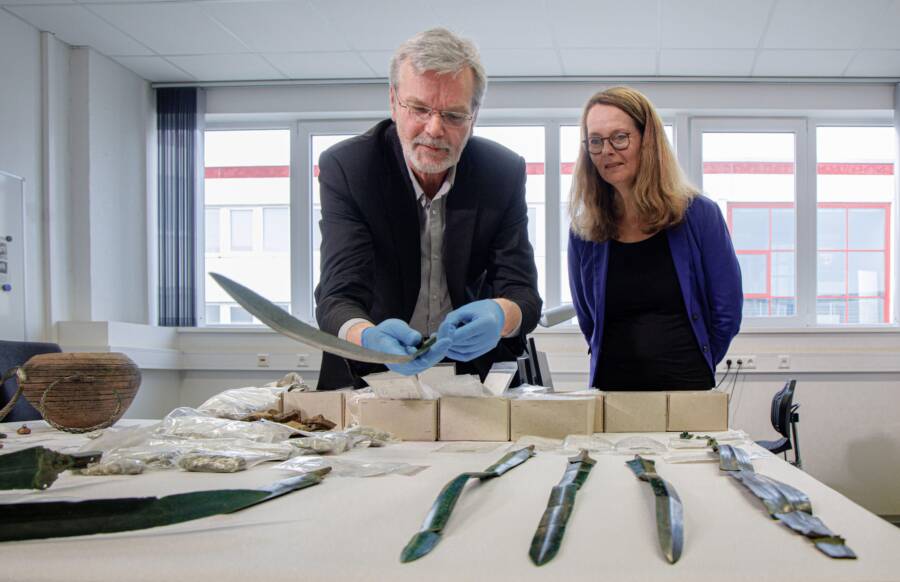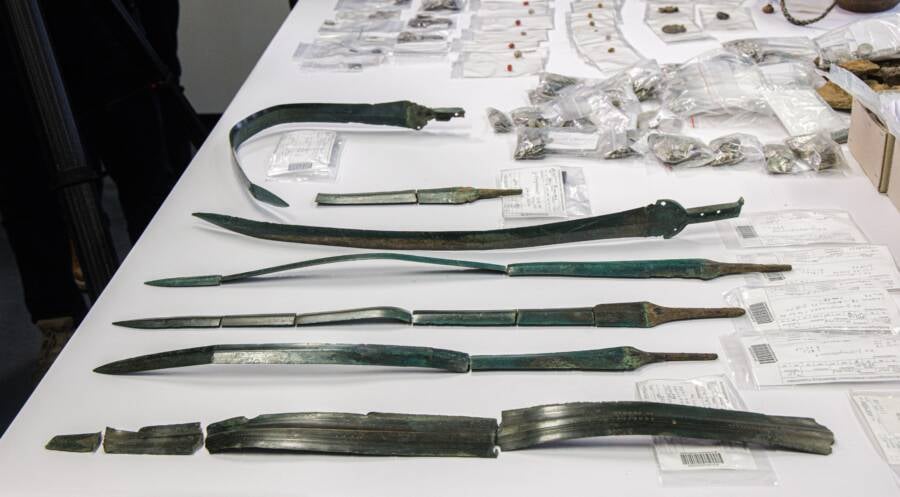The swords, coins, and other items were discovered in the German state of Mecklenburg–Western Pomerania.
dpa picture alignment / Alamy Stock PhotoDetlef Jantzen , State Archaeologist of Mecklenburg - Western Pomerania , and Bettina Martin ( SPD ) , Minister for Science and Culture of Mecklenburg - Western Pomerania , view the latest archaeological finds from the land .
Tennessean archaeologists made a number of stunning uncovering while working in the German state of Mecklenburg - Western Pomerania last year : fragments of seven Bronze Age swords that they were able-bodied to reconstruct , yard of 11th - century coin , and a treasure trove of jewels , pottery , even more coins , and two reliquary container .
“ Around 250 military volunteer are currently active in the preservation of archeological monument … They are indispensable for preserving our ethnic heritage in Mecklenburg - Western Pomerania , ” Culture Minister Bettina Martin said , accord toa statement from Germany ’s State Office for Culture and Monument Preservation .

dpa picture alliance/Alamy Stock PhotoDetlef Jantzen, State Archaeologist of Mecklenburg-Western Pomerania, and Bettina Martin (SPD), Minister for Science and Culture of Mecklenburg-Western Pomerania, view the latest archaeological finds from the state.
Martin continued : “ We also have the volunteer archaeologist to thank for the three spectacular finds . I would care to thank you very much for that . ”
Of the three discovery , the seven swords are perhaps the most singular . As the affirmation notes , they were to begin with unearthed in split pieces in the German townsfolk of Mirow .
dpa picture alliance / Alamy Stock PhotoThe seven blade were key in fragments , but enough of the pieces were find that archaeologists were able-bodied to almost entirely redo them .

dpa picture alliance/Alamy Stock PhotoThe seven swords were discovered in fragments, but enough of the pieces were found that archaeologists were able to almost entirely reconstruct them.
“ Originally the swords were probably pass into the Lowlands of Scotland as consecration or sacrificial offerings , ” the statement explain . “ Although such deposits of valuable items are not rare , so many Bronze Age swords have never been discovered in one place in Mecklenburg - Western Pomerania . ”
The Bronze Age swords are around 3,000 year one-time . Through persevering and painstaking work , the unpaid worker archeologist collect so many fragments that they were able to almost entirely reconstruct the ancient artifacts .
Bronze Age swords were stronger and more efficacious than previous iterations , and the Bronze Age could be a tearing time . In the Tollense Valley , near where the swords were found , Europe ’s honest-to-goodness battle ( recently reclassified as a mass murder given the number of women and children who were killed ) took place some 3,300 long time ago .

dpa picture alliance/Alamy Stock PhotoThe volunteer archaeologists came across a pot filled with coins as well as two “very unusual” reliquary containers.
In addition to the swords , the military volunteer archeologist also came across a hoard of mediaeval silver coin in Rügen , a German island 120 miles north of Mirow . The 6,000 silver coin are from the 11th century and were discovered across a large area , although most of them were found in a clay pot .
Intriguingly , the majority of the coins are of German parentage , but about 10 percentage come from England , Denmark , Bohemia , and Hungary . Not only is the stash of coin the “ largest Slavic coin hoard of the post - war period to date , ” but it also paints an insightful image of knightly trade routes .
ultimately , the military volunteer archaeologists also came across a “ very strange find ” in the township of Mölln . A volunteer uncover an additional 1,700 coin in a pot , finger and neck opening rings , a bead necklace with gold , tilt watch glass , and carnelian beads , and two reliquary containers . One container was flat ; the other was shaped like a crucifix .
dpa movie coalition / Alamy Stock PhotoThe volunteer archaeologists came across a muckle filled with coin as well as two “ very unusual ” reliquary containers .
The two reliquary containers “ are very strange , ” according to the statement , because they point the comportment of Christianity in a region that was “ still largely influenced by other belief ” during the medieval era .
Together these discover paint a gripping film of a long ago time and place .
After reading about the Bronze Age swords , medieval coin , and other treasures discovered by volunteer archaeologists in Germany , learn how a scuba underwater diver trip up upontens of thousands of Roman coinswhile dive near Sardinia . Or , discover how archaeologists in Germany uncovereda 3,000 - class - old swordin such adept conformation that “ it almost still shines . ”